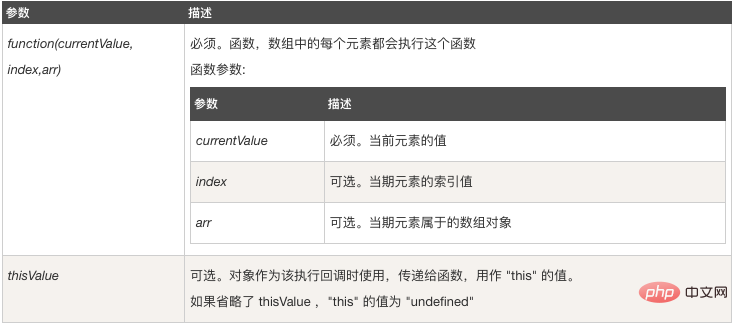Understand the two ways to deduplicate arrays in ES6
This article will introduce to you two ways to deduplicate arrays in ES6. It has certain reference value. Friends in need can refer to it. I hope it will be helpful to everyone.

Related recommendations: "javascript video tutorial"
Two ways to deduplicate arrays in ES6
Method 1:
function unique(arr) {
const res = new Map();
return arr.filter((a) => !res.has(a) && res.set(a, 1))
}It’s as short as that, let’s explain why.
Map object
Map is a new data structure provided by ES6.
Map objects store key-value pairs. Any value (object or primitive) can be used as a key or a value.
The following table lists the methods of the Map object.
| Method | Description |
|---|---|
| Delete all Key/value pairs, no return value. | |
| Delete a key and return true. If deletion fails, return false. | |
| Performs the specified operation on each element. | |
| Returns the value corresponding to the Map object key. | |
| Returns a Boolean value indicating whether a key is in the current Map object. | |
| Set the key/value key/value pair for the Map object. |
The filter() method of array
The filter() method creates a new array. The elements in the new array are determined by checking all elements in the specified array that meet the conditions. .Syntax:
array.filter(function(currentValue,index,arr), thisValue)
Parameter description:

Arrow function
return arr.filter((a) => !res.has(a) && res.set(a, 1))
//上面的代码可以改成这样
return arr.filter(function(a){
return !res.has(a) && res.set(a, 1);
});2. This will not be bound.To learn more, click here
Method one analysis
function unique(arr) {
//定义常量 res,值为一个Map对象实例
const res = new Map();
//返回arr数组过滤后的结果,结果为一个数组
//过滤条件是,如果res中没有某个键,就设置这个键的值为1
return arr.filter((a) => !res.has(a) && res.set(a, 1))
}Method two:
function unique(arr) {
return Array.from(new Set(arr))
}
The from method of array
Syntax:
Array.from(arrayLike[, mapFn[, thisArg]])
| Description | |
|---|---|
| Required, an array-like object or iterable object that you want to convert to a real array. | |
| Optional, if this parameter is specified, the finally generated array will be processed by this function and then returned. | |
| Optional, the value of this when executing the mapFn function. |
Sample code:
const bar = ["a", "b", "c"];
Array.from(bar);
// ["a", "b", "c"]
Array.from('foo');
// ["f", "o", "o"]Set object
Set object allows you to store A unique value of any type, whether a primitive value or an object reference.A Set object is a collection of values, and you can iterate its elements in the order of insertion.
The elements in the Set will only appear once, that is, the elements in the Set are unique.
Syntax:
new Set([iterable]);
Parameters: iterable, if you pass an iterable object (including Array, Map, Set, String, TypedArray, arguments object, etc.), all its elements will be added to the new Set. If this parameter is not specified or its value is null, the new Set is empty.
| Description | |
|---|---|
| Add someone value, returning the Set object itself. | |
| Deletes all key/value pairs and returns no value. | |
| Delete a key and return true. If deletion fails, return false. | |
| Performs the specified operation on each element. | |
| Returns a Boolean value indicating whether a key is in the current Set object. |
The above is the detailed content of Understand the two ways to deduplicate arrays in ES6. For more information, please follow other related articles on the PHP Chinese website!

Hot AI Tools

Undresser.AI Undress
AI-powered app for creating realistic nude photos

AI Clothes Remover
Online AI tool for removing clothes from photos.

Undress AI Tool
Undress images for free

Clothoff.io
AI clothes remover

AI Hentai Generator
Generate AI Hentai for free.

Hot Article

Hot Tools

Notepad++7.3.1
Easy-to-use and free code editor

SublimeText3 Chinese version
Chinese version, very easy to use

Zend Studio 13.0.1
Powerful PHP integrated development environment

Dreamweaver CS6
Visual web development tools

SublimeText3 Mac version
God-level code editing software (SublimeText3)

Hot Topics
 How to implement an online speech recognition system using WebSocket and JavaScript
Dec 17, 2023 pm 02:54 PM
How to implement an online speech recognition system using WebSocket and JavaScript
Dec 17, 2023 pm 02:54 PM
How to use WebSocket and JavaScript to implement an online speech recognition system Introduction: With the continuous development of technology, speech recognition technology has become an important part of the field of artificial intelligence. The online speech recognition system based on WebSocket and JavaScript has the characteristics of low latency, real-time and cross-platform, and has become a widely used solution. This article will introduce how to use WebSocket and JavaScript to implement an online speech recognition system.
 WebSocket and JavaScript: key technologies for implementing real-time monitoring systems
Dec 17, 2023 pm 05:30 PM
WebSocket and JavaScript: key technologies for implementing real-time monitoring systems
Dec 17, 2023 pm 05:30 PM
WebSocket and JavaScript: Key technologies for realizing real-time monitoring systems Introduction: With the rapid development of Internet technology, real-time monitoring systems have been widely used in various fields. One of the key technologies to achieve real-time monitoring is the combination of WebSocket and JavaScript. This article will introduce the application of WebSocket and JavaScript in real-time monitoring systems, give code examples, and explain their implementation principles in detail. 1. WebSocket technology
 How to implement an online reservation system using WebSocket and JavaScript
Dec 17, 2023 am 09:39 AM
How to implement an online reservation system using WebSocket and JavaScript
Dec 17, 2023 am 09:39 AM
How to use WebSocket and JavaScript to implement an online reservation system. In today's digital era, more and more businesses and services need to provide online reservation functions. It is crucial to implement an efficient and real-time online reservation system. This article will introduce how to use WebSocket and JavaScript to implement an online reservation system, and provide specific code examples. 1. What is WebSocket? WebSocket is a full-duplex method on a single TCP connection.
 Specify the basis for removing duplicate elements when deduplicating PHP arrays
Apr 28, 2024 pm 10:48 PM
Specify the basis for removing duplicate elements when deduplicating PHP arrays
Apr 28, 2024 pm 10:48 PM
PHP's array_unique() function is used to remove duplicate elements from an array. By default, strict equality (===) is used. We can specify the basis for deduplication through a custom comparison function: create a custom comparison function and specify the deduplication standard (for example, based on element length); pass the custom comparison function as the third parameter to the array_unique() function. Remove duplicate elements based on specified criteria.
 How to use JavaScript and WebSocket to implement a real-time online ordering system
Dec 17, 2023 pm 12:09 PM
How to use JavaScript and WebSocket to implement a real-time online ordering system
Dec 17, 2023 pm 12:09 PM
Introduction to how to use JavaScript and WebSocket to implement a real-time online ordering system: With the popularity of the Internet and the advancement of technology, more and more restaurants have begun to provide online ordering services. In order to implement a real-time online ordering system, we can use JavaScript and WebSocket technology. WebSocket is a full-duplex communication protocol based on the TCP protocol, which can realize real-time two-way communication between the client and the server. In the real-time online ordering system, when the user selects dishes and places an order
 JavaScript and WebSocket: Building an efficient real-time weather forecasting system
Dec 17, 2023 pm 05:13 PM
JavaScript and WebSocket: Building an efficient real-time weather forecasting system
Dec 17, 2023 pm 05:13 PM
JavaScript and WebSocket: Building an efficient real-time weather forecast system Introduction: Today, the accuracy of weather forecasts is of great significance to daily life and decision-making. As technology develops, we can provide more accurate and reliable weather forecasts by obtaining weather data in real time. In this article, we will learn how to use JavaScript and WebSocket technology to build an efficient real-time weather forecast system. This article will demonstrate the implementation process through specific code examples. We
 Simple JavaScript Tutorial: How to Get HTTP Status Code
Jan 05, 2024 pm 06:08 PM
Simple JavaScript Tutorial: How to Get HTTP Status Code
Jan 05, 2024 pm 06:08 PM
JavaScript tutorial: How to get HTTP status code, specific code examples are required. Preface: In web development, data interaction with the server is often involved. When communicating with the server, we often need to obtain the returned HTTP status code to determine whether the operation is successful, and perform corresponding processing based on different status codes. This article will teach you how to use JavaScript to obtain HTTP status codes and provide some practical code examples. Using XMLHttpRequest
 How to use insertBefore in javascript
Nov 24, 2023 am 11:56 AM
How to use insertBefore in javascript
Nov 24, 2023 am 11:56 AM
Usage: In JavaScript, the insertBefore() method is used to insert a new node in the DOM tree. This method requires two parameters: the new node to be inserted and the reference node (that is, the node where the new node will be inserted).







